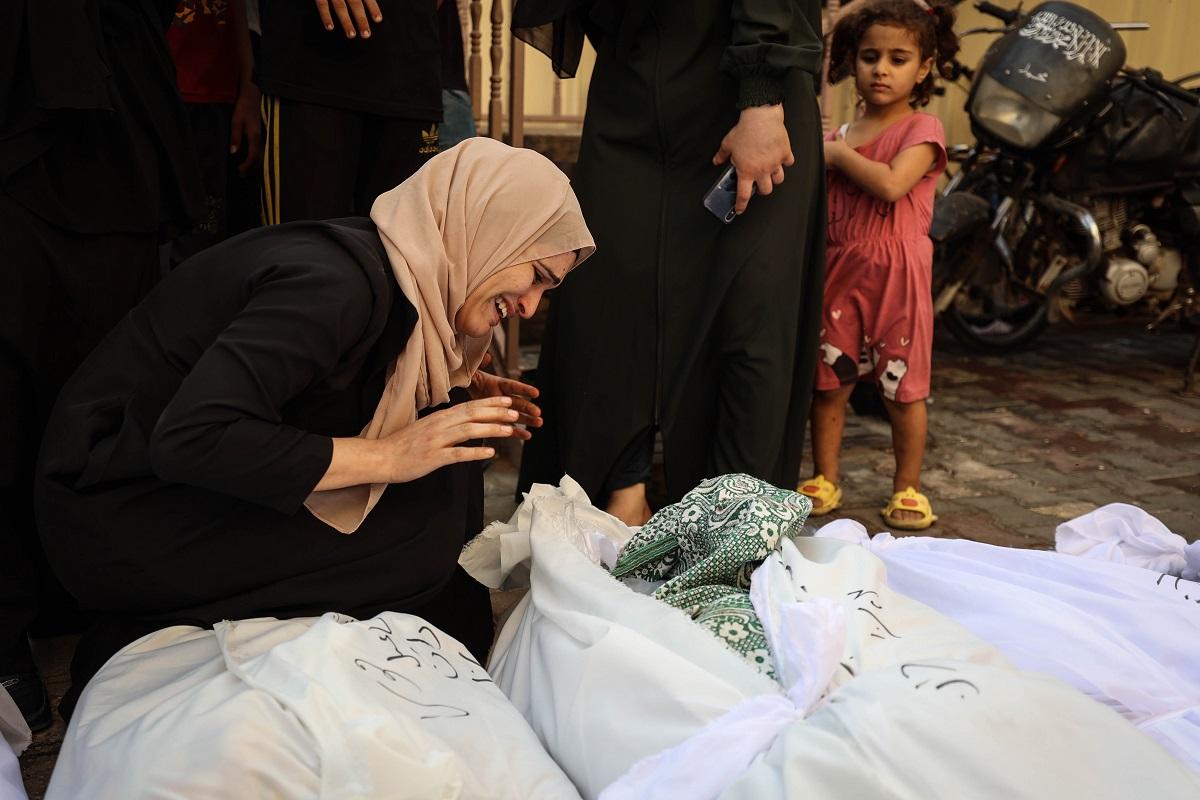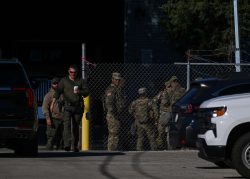
A woman cries over the body of a relative in Deir Al-Balah, in the central Gaza Strip, as the dead are readied for burial.
11:31 JST, October 24, 2023
JERUSALEM – From the air, Israel hit 320 “terror targets” in Gaza, including Hamas tunnels and dozens of command centers, Israel’s military said Monday. On the ground, residential buildings were leveled and more than 400 people were killed in a 24-hour period, according to the Gaza Health Ministry, an agency of the Hamas-controlled government.
On the 17th day since Hamas’s brutal surprise attack, the Israel-Gaza war expanded in words, deeds and scope, even as diplomatic and humanitarian drives to ease the conflict accelerated.
Israel continued to warn that it is preparing a ground invasion of Gaza, yet the command to begin that attack has not come. Western leaders are urging Israel to hold off while talks continue toward the freeing of more hostages.
In a possible nod in that direction, Hamas late Monday released two hostages, Yocheved Lifshitz and Nurit Cooper, Israeli women in their 70s and 80s, to the Red Cross following mediation efforts by Qatar and Egypt. The women crossed through Gaza’s Rafah border station into Egypt, were driven away from the border in ambulances and helicoptered to an Israeli hospital. Hamas said over the weekend that it sought to release the two for “crushing humanitarian reasons.” Both women’s husbands remain in captivity.
Hamas and Israel mark each day of war with new numbers measuring the accumulation of death and destruction. The Gaza Health Ministry said more than 5,000 Gaza residents have been killed so far, including 436 in the past 24 hours, primarily in the enclave’s south, where Israel has told more than 1 million Gazans to seek shelter from air raids in the north. The ministry’s figures, which could not be independently confirmed, are not broken down between civilians and militants.
Israel issued a new tally of the hostages – 222 in the latest accounting – taken by Hamas commandos during their Oct. 7 assault.
Israel Defense Forces spokesman Rear Adm. Daniel Hagari said Monday that one Israeli soldier was killed and three wounded in the latest operations in Gaza, which he described as “limited raids” to “get intelligence on the missing and the hostages.”
The IDF said it has now killed five Hamas air force commanders, including Ibrahim al-Sahar, whom Israel called the “head of the antitank battery” of the group’s northern division. Officials said he was responsible for planning and directing missile attacks, including one that killed an Israeli soldier in 2021.
Touring his country’s southern border Monday, Israeli Defense Minister Yoav Gallant said, “We are preparing thoroughly for the next step – a multilateral operation in the air, ground and sea.” After joining a navy patrol off Israel’s southern coast, Gallant told the forces that “it will come soon.”
“Do your work, get ready,” he said. “We will need you.”
As the conflict on the ground and in the air heated up, diplomatic and humanitarian initiatives also gained momentum. A third convoy of trucks carrying food, water and medicine entered Gaza through the border with Egypt on Monday. Israeli officials said they inspected the cargo to ensure that no fuel was delivered to Gaza, because they fear it would be used to power Hamas rockets.
A U.N. spokesman, Stéphane Dujarric, said the shipments so far amount to 4 percent of the usual “daily average of commodities entering Gaza.” About 220 trucks are “ready and willing to go in,” he said.
Following two smaller hostage handovers to date, talks between Qatari officials and Hamas seemed Monday to focus on a potential release of about 50 hostages who hold dual nationality.
In Israel, Dutch Prime Minister Mark Rutte and Greek Prime Minister Kyriakos Mitsotakis visited Israeli leaders. French President Emmanuel Macron prepared to follow them on Tuesday.
In his session with Mitsotakis, Israeli Prime Minister Benjamin Netanyahu thanked the Greek leader for his country’s support and described the war as “civilization against barbarism. We’re on the side of civilization. We have to unite, all together, against Hamas, which is ISIS,” he said, using an acronym for the Islamic State.
At al-Shifa Hospital, Gaza’s largest, at least 150 people died or were dead on arrival between Sunday and Monday morning, according to a medical worker who spoke on the condition of anonymity to protect their safety. The hospital is treating more than 5,000 people, U.N. officials said, compared with its normal patient count of about 700.
The worker said more than 100 of the deaths occurred overnight, “because the targeting of residential houses happens at night when they are asleep with no warnings beforehand.”
In central Gaza, a doctor at Shuhada’ al-Aqsa Hospital, speaking on the condition of anonymity to protect the medical staff’s safety, described a scene of mass death and critical injuries on what the physician called “the most violent day” of the war.
“We have turned a school next to the hospital into a makeshift hospital to treat the less critically wounded,” the doctor said. “We have a huge number of people who took refuge in the hospital. We are too busy to count them, but huge numbers. They feel safer inside the hospital.”
At the Rafah border crossing, aid vehicles entered the Palestinian enclave Monday carrying 20 truckloads of food, water and medicines – part of what the White House called a “continued flow” of aid that Netanyahu and President Biden agreed to in a call on Sunday. The United Nations has said Gaza needs about 100 trucks a day to meet its most urgent needs.
Emergency officials in Gaza called the new aid a drop in a bucket of need and lamented the lack of fuel, which the densely populated territory needs to power generators to pump water and produce electricity.
The Gaza Health Ministry said Monday that hospitals and clinics throughout the strip are collapsing and running out of basic supplies.
At Nasser Hospital in the southern Gaza city of Khan Younis, the chief of the neonatal unit, Hatem Edhair, said the facility will run out of fuel by Wednesday, leaving the eight babies in the intensive care unit and 10 in the neonatal ward at severe risk because half of them are on oxygen and CPAP (pressurized air) machines.
“If the hospital runs out of fuel, half of these babies will die in less than 24 hours,” Edhair said.
In small ground raids into Gaza, IDF soldiers were searching for missing Israelis when they came under attack near Kissufim, said Hagari, the IDF spokesman. He said an antitank missile was fired at an Israeli tank and an engineering vehicle.
The armed wing of Hamas, the Izzedine al-Qassam Brigades, confirmed Sunday night that forces “engaged with the infiltrating force, destroying two bulldozers and a tank and forced the [Israeli troops] to withdraw.”
Israeli airstrikes in Gaza on Monday “directly” hit more than 18 residential buildings, according to the Hamas government press office. A strike Monday morning hit a residential building in Jabalya, killing 17 people and injuring dozens more, the Health Ministry in Gaza said.
Among the dead were at least 11 members of Khail Abu Yahia’s family, six of whom were children, he told The Washington Post by phone from central Gaza.
The others killed were his relative’s neighbors, he said. He expected the death toll to rise because some of the injured were badly disfigured.
“The children were supposed to be at school with exams, but like every other kid in Gaza, they were sitting in their homes,” Abu Yahia said. “Then, all of a sudden, Israel bombed their house without any prior warning.”
The attacks continued through the night Monday with a strike on a residential complex in the Shati refugee camp in the north. “Scores” of people were killed and wounded, a Health Ministry spokesman told Reuters.
The war has already displaced more than 1 million people in Gaza, as residents flee air raids and heed Israeli warnings to evacuate, and hundreds of thousands in Israel, where the Hamas attack devastated towns across the south and where the military is working to evacuate northern communities that are vulnerable to Hezbollah assaults from Lebanon.
In Israel, tent cities are popping up on athletic fields and near community centers to accommodate some of the estimated 300,000 people who fled areas near the Gaza and Lebanon borders. In Eilat on the Red Sea, Mayor Eli Lankri said his city’s population had doubled and its 12,000 hotel rooms were full of displaced people.
For Gazans, after more than two weeks of war, there remains nowhere safe to go as despair and anger grow. Many Israelis want Hamas and its forces destroyed once and for all, whatever the cost.
At a briefing at Israel’s air force operations command and control center, Gallant said that a ground campaign in Gaza “may take a month, two or three, but at the end there will be no more Hamas.”
"News Services" POPULAR ARTICLE
-

American Playwright Jeremy O. Harris Arrested in Japan on Alleged Drug Smuggling
-

Japan’s Nikkei Stock Average as JGB Yields, Yen Rise on Rate-Hike Bets
-

Japan’s Nikkei Stock Average Licks Wounds after Selloff Sparked by BOJ Hike Bets (UPDATE 1)
-

Japan’s Nikkei Stock Average Buoyed by Stable Yen; SoftBank’s Slide Caps Gains (UPDATE 1)
-

Japanese Bond Yields Zoom, Stocks Slide as Rate Hike Looms
JN ACCESS RANKING
-

Tokyo Economic Security Forum to Hold Inaugural Meeting Amid Tense Global Environment
-

Keidanren Chairman Yoshinobu Tsutsui Visits Kashiwazaki-Kariwa Nuclear Power Plant; Inspects New Emergency Safety System
-

Imports of Rare Earths from China Facing Delays, May Be Caused by Deterioration of Japan-China Relations
-

University of Tokyo Professor Discusses Japanese Economic Security in Interview Ahead of Forum
-

Japan Pulls out of Vietnam Nuclear Project, Complicating Hanoi’s Power Plans
























